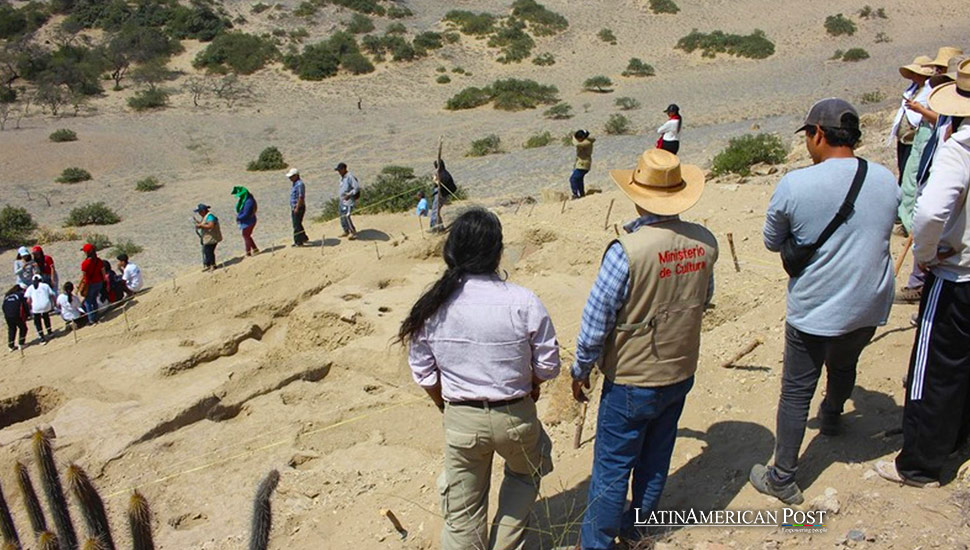Ancient Peruvian Temple Ruins Unearthed by Archaeologists

In northern Peru, archaeologists have uncovered a 4,000-year-old ceremonial temple buried in a dune, revealing skeletal remains and potential ritual offerings, shedding new light on the region’s ancient religious traditions.
A team of archaeologists has discovered the ruins of what appears to be a 4,000-year-old ceremonial temple buried in a dune in northern Peru, alongside skeletal human remains that may have been offerings for religious rituals. The ruins were found in the sandy desert district of Zana, in the Lambayeque region, just a short stretch from the Pacific Ocean and approximately 780 km (484 miles) north of the capital, Lima.
“We are still waiting for radiocarbon dating to confirm the date, but the evidence suggests this religious construction could be part of a religious tradition of temples built on Peru’s northern coast during that period,” said Luis Muro, an archaeologist from Peru’s Pontifical Catholic University who led the research. Muro’s team found the skeletal remains of three adults between the walls and bases of what was once a multi-story structure, one of which was accompanied by offerings and possibly wrapped in a kind of linen or clothing.
A Glimpse into Ancient Rituals
One of the temple walls features a high-relief drawing of a mythological figure with a human body and a bird’s head, a design that Muro said predates the pre-Hispanic Chavin culture that populated the central Peruvian coast for over half a millennia from around 900 BC. This discovery hints at a rich tapestry of religious traditions that existed long before the Chavin, showing the region’s continuity and evolution of spiritual practices.
Muro’s findings suggest that these early inhabitants engaged in complex ceremonial activities, potentially involving human sacrifices. The presence of skeletal remains with offerings indicates that these rituals were a significant aspect of their cultural and religious life. This discovery enriches our understanding of Peru’s ancient history and highlights the sophistication of early Andean civilizations.
Comparing with Other Ancient Sites
Northern Peru is home to several other ancient ceremonial complexes. For example, the Sacred City of Caral, located about 5,000 years old, is one of the oldest known urban centers in the Americas. Caral’s extensive ruins provide insight into early urban planning, architecture, and social organization. The discovery in Zana adds another layer to this historical narrative, showing that advanced ceremonial practices were widespread across the region.
In contrast, southern Peru’s Ica region hosts the Nazca lines, mysterious geoglyphs carved into the desert more than 1,500 years ago. These lines, depicting various animals and shapes, are believed to have had ritual astronomical functions. While Caral and Nazca are well-known, the newly uncovered temple in Zana offers fresh perspectives on the diversity and reach of ancient Peruvian civilizations.
Muro said remains of another temple might have been found in another excavation nearby, belonging to the late Moche culture, which arose about 1,400 years ago across the country’s northern coast. The Moche are known for their impressive pyramids and intricate pottery, indicating a high level of artistic and architectural skill. The proximity of different cultural layers in northern Peru suggests a rich and interconnected history of religious and societal development.
Peru’s Archaeological Riches
Peru’s most prominent archaeological site is the Incan citadel Machu Picchu, nestled in the mountainous Cusco province. Built in the mid-15th century, this World Heritage site draws millions of visitors annually, captivated by its stunning location and historical significance. Machu Picchu is a testament to the Incan Empire’s engineering prowess and cultural achievements.
The discovery in Zana adds to the extensive list of Peru’s archaeological treasures, offering a glimpse into a much earlier period of human civilization. These findings underscore the importance of ongoing archaeological efforts to uncover and preserve Peru’s rich heritage. Each discovery, whether a temple in the northern desert or an ancient city in the highlands, provides valuable insights into this Andean nation’s diverse and dynamic history.
With its diverse and layered history, Northern Peru continues to be a focal point for archaeological research. The region’s harsh environment, with its scorching daytime temperatures and frigid nights, has preserved many ancient sites remarkably well. This preservation allows archaeologists to piece together the lives and practices of early civilizations, contributing to a broader understanding of human history in the Americas.
A Continuous Journey of Discovery
As archaeologists continue their work in Zana and other parts of Peru, the story of this ancient land becomes more prosperous and complex. The newly uncovered temple, with its unique architectural features and ceremonial artifacts, sheds light on the religious practices of a civilization that thrived 4,000 years ago. The high-relief drawing of the mythological figure with a bird’s head offers a tantalizing glimpse into the symbolic world of these early Peruvians.
The discovery also highlights the role of international collaboration in archaeological research. Scholars worldwide are drawn to Peru’s rich archaeological landscape, bringing diverse perspectives and expertise to studying ancient Andean cultures. These collaborative efforts are essential for unraveling the mysteries of the past and preserving these cultural treasures for future generations.
Also read: Irish Investors to Produce Green Hydrogen in Southern Peru
The discovery of a 4,000-year-old ceremonial temple in northern Peru significantly adds to our understanding of ancient American civilizations. This find, along with other prominent sites like Caral, the Nazca lines, and Machu Picchu, underscores Peru’s rich and diverse history. As archaeologists continue to uncover past secrets, the story of Peru’s ancient peoples becomes ever more fascinating and intricate. The skeletal remains, the high-relief drawings, and the offerings found at the site all contribute to a deeper appreciation of early Peruvian societies’ cultural and religious complexity.





